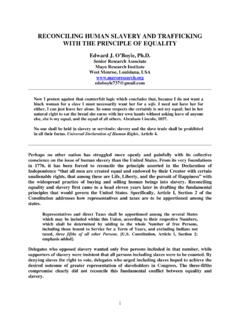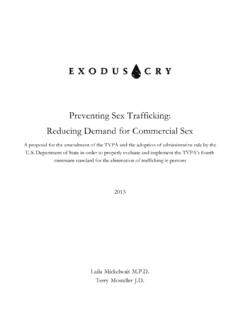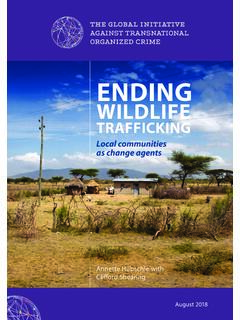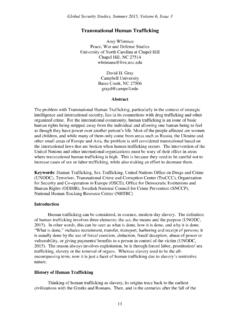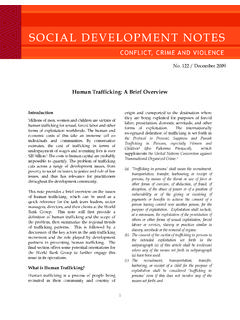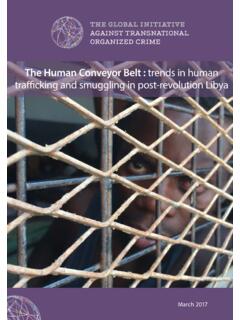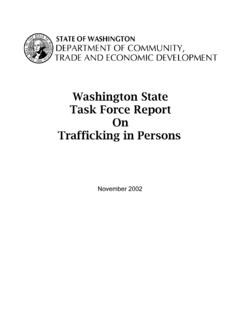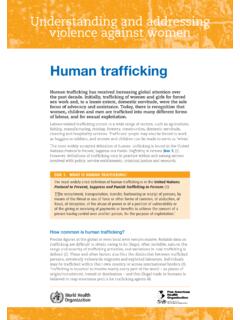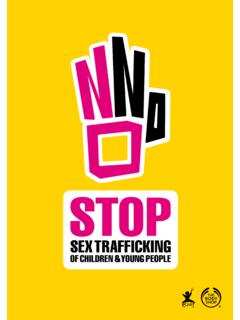Transcription of Trafficking in Persons and U.S. Foreign Policy Responses ...
1 Trafficking in Persons and Foreign Policy Responses in the 114th congress Liana W. Rosen Specialist in International Crime and Narcotics August 5, 2016 Congressional Research Service 7-5700 R44581 Trafficking in Persons and Foreign Policy Responses in the 114th congress Congressional Research Service Summary Trafficking in Persons , or human Trafficking , refers to the subjection of men, women, and children to exploitative conditions that may be tantamount to slavery. Reports suggest that human Trafficking is a global phenomenon, victimizing millions of people each year and contributing to a multi-billion dollar criminal industry. Common forms of human Trafficking include Trafficking for commercial sexual exploitation, forced labor, and debt bondage. Other forms of human Trafficking include Trafficking for domestic servitude and the use of children in armed conflict ( , child soldiers).
2 Human Trafficking is a centuries-old problem that, despite international and efforts to eliminate it, continues to occur in virtually every country in the world. The modern manifestation of the human Trafficking problem is driven by gaps in the enforcement of anti- Trafficking laws and regulations and the willingness of some labor and service providers to violate such laws in order to fulfill international demand. Such demand is particularly concentrated among industries and economic sectors that are low-skill and labor-intensive. Human Trafficking is an international and cross-cutting Policy problem that affects a range of major national security, human rights, criminal justice, social, economic, migration, gender, public health, and labor issues. The government and successive Congresses have long played a leading role in international efforts to combat human Trafficking .
3 The Trafficking Victims Protection Act (TVPA, Division A of 106-386, as amended) and its reauthorizations are the cornerstone legislative vehicles for current Policy to combat international human Trafficking . Since enactment of the TVPA in 2000, congress has remained active on international human Trafficking issues, particularly with appropriations identified for anti- Trafficking assistance purposes, proposed legislation related to the TVPA, and other anti- Trafficking initiatives. Periodic oversight hearings have focused in particular on the State Department s annual Trafficking in Persons (TIP) report , a detailed country-by-country ranking and analysis of government efforts to achieve congressionally established minimum standards for the elimination of human Trafficking . Although there is widespread support among Policy makers for anti- Trafficking goals, ongoing reports of continued Trafficking worldwide raise questions regarding whether sufficient progress has been made to deter and ultimately eliminate the problem.
4 This report provides an overview of recent global trends and Foreign Policy Responses to address human Trafficking . The report focuses in particular on efforts conducted by the State Department s Office to Monitor and Combat Trafficking in Persons (J/TIP) and the President s Interagency Task Force (PITF) on human Trafficking , as well as discussion of the 2016 TIP report . An Appendix includes the status of legislation introduced in the 114th congress on international dimensions of human Trafficking . Drawing on CRS report R42497, Trafficking in Persons : International Dimensions and Foreign Policy Issues for congress , this report reflects Policy activity in the 114th congress and will be updated to reflect international Trafficking developments through the end of the second session.. Trafficking in Persons and Foreign Policy Responses in the 114th congress Congressional Research Service Contents global Trends.
5 1 Policy Background .. 2 Agency Roles and Responsibilities .. 3 The State Department s Office to Monitor and Combat Trafficking in Persons .. 3 The President s Interagency Task Force .. 4 Other Agencies .. 5 United Nations Role .. 6 State Department Reporting Requirements .. 7 2016 TIP Interim Assessment .. 7 2016 TIP report .. 8 Tier 1 Countries .. 8 Tier 2 Countries .. 8 Tier 2 Watch List Countries .. 9 Tier 3 Countries .. 10 Annual List of Countries Involved in Recruiting and Using Child Soldiers .. 11 report Methodology and Credibility .. 12 Early Reactions to the 2016 TIP report .. 12 Funding and Assistance Issues .. 14 Tables Table 1. Tier 1 Countries in the 2016 TIP report .. 8 Table 2. Tier 2 Countries in the 2016 TIP report .. 9 Table 3. Tier 2 Watch List Countries in the 2016 TIP report .. 10 Table 4. Tier 3 Countries in the 2016 TIP report .. 11 Appendixes Appendix.
6 International Human Trafficking Legislation in the 114th congress .. 16 Contacts Author Contact Information .. 18 Trafficking in Persons and Foreign Policy Responses in the 114th congress Congressional Research Service 1 global Trends Trafficking in Persons , or human Trafficking , refers to the subjection of men, women, and children to compelled service for the purposes of Examples of human Trafficking include Trafficking for commercial sexual exploitation, including child sexual exploitation; forced labor, including bonded labor, involuntary domestic servitude, and forced child labor; and the unlawful recruitment and use of child soldiers. Reports suggest that human Trafficking is a global phenomenon, victimizing millions of people and contributing to a multi-billion dollar criminal industry. It is a centuries-old problem that, despite international efforts, continues to occur in virtually every country in the world.
7 On June 30, 2016, the State Department released its latest edition of the flagship annual publication on international human Trafficking , the Trafficking in Persons (TIP) report , discussed further in the State Department Reporting Requirements section below. Briefly, the TIP report categorized 185 countries, including the United States, into four tiers, based on their respective governments level of effort to address human Trafficking : Tier 1 (best), Tier 2, Tier 2 Watch List, and Tier 3 (worst). An additional three countries were designated as Special Cases without a tier ranking because of political instability and the inability to obtain relevant government information. Only Tier 1 countries, approximately of the countries assessed, were fully compliant with minimum standards to eliminate severe forms of human Trafficking ; the rest were considered noncompliant and varied in terms of their level of effort to improve.
8 Among the least compliant were the 27 countries identified as Tier 3 in the 2016 TIP report , including 8 that had previously been Tier 2 Watch List: Burma, Djibouti, Haiti, Papua New Guinea, Sudan, Suriname, Turkmenistan, and Uzbekistan. As required by law, Tier 3 countries are subjected to selected Foreign assistance restrictions, unless the President determines that continuing to provide aid is in the national interest. The nongovernmental organization Walk Free Foundation also provided a global evaluation of human Trafficking trends in its 2016 global Slavery Index report . 2 The 2016 global Slavery Index report estimated that some million (up from million estimated in 2014) individuals worldwide were exploited through human Trafficking , forced labor, debt bondage, forced or servile marriage, or commercial sexual exploitation. In contrast to the TIP report , which categorizes countries solely on the basis of government efforts, the global Slavery Index also seeks to provide country-by-country estimates of people experiencing conditions tantamount to modern slavery.
9 For example, the 2016 global Slavery Index reported the following: Countries with the greatest prevalence of their population subjected to modern slavery included North Korea (for comparison, the State Department listed North Korea as Tier 3 in the 2016 TIP report ), Uzbekistan (Tier 3), Cambodia (Tier 2), India (Tier 2), and Qatar (Tier 2 Watch List). Countries with the highest absolute numbers of people subjected to modern slavery, according to the 2016 global Slavery Index, included India (Tier 2 in the 2016 TIP report ), China (Tier 2 Watch List), Pakistan (Tier 2 Watch List), Bangladesh (Tier 2), and Uzbekistan (Tier 3). 1 See also CRS report R42497, Trafficking in Persons : International Dimensions and Foreign Policy Issues for congress . 2 Walk Free Foundation, 2016 global Slavery Index, 2016. Trafficking in Persons and Foreign Policy Responses in the 114th congress Congressional Research Service 2 Countries taking the least action to address human Trafficking included North Korea (Tier 3 in the 2016 TIP report ), Iran (Tier 3), Eritrea (Tier 3), Equatorial Guinea (Tier 3), Papua New Guinea (Tier 3), Guinea (Tier 2 Watch List), the Democratic Republic of the Congo (DRC, Tier 2 Watch List), and South Sudan (Tier 3).
10 Several other older, but nevertheless widely referenced global reports on human Trafficking include a 2014 report prepared by the United Nations Office on Drugs and Crime (UNODC) and two reports prepared by the International Labor Organization (ILO). Surveying member countries, UNODC reported in 2014 that, between 2010 and 2012, 124 countries had identified Trafficking victims representing 152 The UNODC report cautioned that its estimates were minimum figures, as it is generally recognized that the actual scope and prevalence of human Trafficking is far higher than officially reported. The UNODC report also revealed that Trafficking operations were seemingly as diverse as they were widespread, ranging from individuals exploiting their partners or employees to highly sophisticated transnational criminal syndicates involving a large number of victims. In 2012, the ILO estimated that some million men, women, and children were subjected to forced labor, including Trafficking , debt bondage, and slavery-like In 2014, the ILO followed up with an analysis of the financial value of forced labor and related Trafficking on the international economy, estimating that it generated $150 billion in illegal profits According to the ILO, two-thirds of this total amount stemmed from commercial sexual exploitation, while the rest resulted from forced labor.










